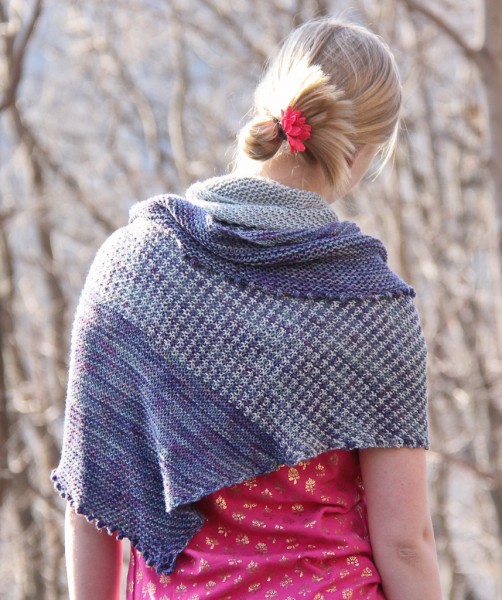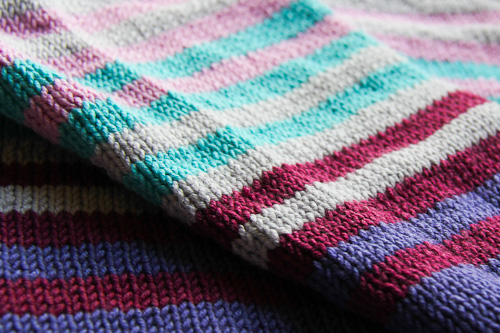I like to use every last bit of my yarn whenever possible; it both appeals to my frugal side, and justifies the purchase of new stash, since I’m using what I have so wisely. My ideal shawl is one like Sundry, where you can knit until you run out of yarn, leaving only enough for the bind off. I also find myself eking out sweaters with slightly-too-little yardage, by saving the sleeve cuffs for last (even after finishing!) and working both simultaneously until zero yarn remains.

That still means you have to make sure you actually have enough so that you don’t get a dozen stitches from a completed bind off with 1″ of yarn remaining – one of a knitter’s most painful moments. There are several ways you can estimate how much to leave, in order to maximize your yardage.
1. The rule of thumb is to leave about 3 times the length of the row, or approximately 1″ of yarn per stitch. These guesstimates can both be done quickly, and you can choose a rough average of the two and proceed. This can be a slightly reckless approach good for the the live dangerously type, and the possibility that you wont have enough increases as your gauge gets larger. If you’re working with superbulky yarn, try leaving at least 4 times the length of the row for starters.
2. If you can brave a bit more math, there are more options. For the stitch-count lovers (I’m talking to you, spreadsheet people) pick a small number of stitches evenly divisible into the total stitches you will have for the row in question. Measure how much yarn it takes to knit that small number – just knit them, then tink and measure the yarn. Multiply that measurement by the number of times your small number is divisible into your total. Let’s say your questionable row has 200 stitches; knit 20, mark the yarn with a paperclip, tied-on scrap or by just pinching with your finger, then tink back and measure how much yarn those 20 stitches required. Multiply by 10 and that’s about how much you’ll need for the row. Technically that’s how much you’d need to knit the row, which is good if you’re finishing a section; binding off can take a bit more, especially if it’s a stretchy through the back loop type – either add in some extra, or more scientifically, bind off those 20 stitches and measure the yardage it takes.
3. For the math-y visual types, you can run a full trial row – and again this is more indicative of the amount necessary to work the row rather than to bind it off. Pull out a few yards from the skein, more than you think you need, and measure off an arbitrary amount, 6′ for example. Mark the 6′ with a slipknot or the handy tied-on scrap. Then work the trial row, and measure how much is left before the marked off amount, in order to determine how much yardage the row used. In our example, if 12″ remain before your marker, you know that one row requires 5′ of yarn. It’s a good idea to leave a little more, just in case.
4. Finally, my favorite scientific variation of number 3, and the method that I think is most accurate, is to weigh your yarn. I use the digital scale, set to grams. As you’re nearing the bind off or the row in question, weigh the remaining yarn in the skein. Work the row, then weigh again; that’s the amount needed for the row. If you haven’t waited to do this until the almost bitter end, you can easily check several rows and average the amounts, if they show any difference. I think this method is the simplest, too, because there’s no measuring and no math – just pop the skein onto the scale. For a bind off, I leave extra – perceptually, even doubling the 2 grams of sock yarn that the scale says I need to 4 grams, still makes me feel virtuous and thrifty.
Then congratulate yourself on your success, and go out and buy another skein; you deserve it for managing your resources so wisely.



